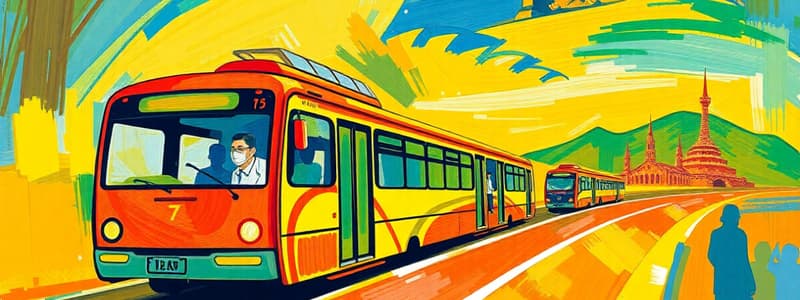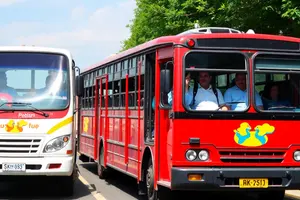Podcast
Questions and Answers
Transportation's primary role in tourism involves connecting international boundaries.
Transportation's primary role in tourism involves connecting international boundaries.
True (A)
The module focuses on the principles of tourism marketing.
The module focuses on the principles of tourism marketing.
False (B)
Tourist destinations can significantly benefit even from inefficient transport systems.
Tourist destinations can significantly benefit even from inefficient transport systems.
False (B)
Transportation has no negative impacts on tourism.
Transportation has no negative impacts on tourism.
The economy of scale in transportation is characterized by increased cost per unit with larger shipment sizes.
The economy of scale in transportation is characterized by increased cost per unit with larger shipment sizes.
Economy of distance implies that transportation costs per unit increase with greater distance.
Economy of distance implies that transportation costs per unit increase with greater distance.
Mass transit is considered less environmentally friendly than private vehicle use.
Mass transit is considered less environmentally friendly than private vehicle use.
Mass transit excludes members of society irrespective of financial status.
Mass transit excludes members of society irrespective of financial status.
Transit systems guarantee more business for commercial development and lead to an increase in the price of properties.
Transit systems guarantee more business for commercial development and lead to an increase in the price of properties.
Mass transit systems reduce traffic congestion by facilitating a higher volume of passengers.
Mass transit systems reduce traffic congestion by facilitating a higher volume of passengers.
Mass transit systems are economically feasible in areas with sparse populations.
Mass transit systems are economically feasible in areas with sparse populations.
Passengers generally find travel via mass transportation systems particularly comfortable and convenient.
Passengers generally find travel via mass transportation systems particularly comfortable and convenient.
Air travel is the slowest among all modes of transport.
Air travel is the slowest among all modes of transport.
The development of air transport mainly occurred before World War I.
The development of air transport mainly occurred before World War I.
Land transport exclusively involves air-based transit systems.
Land transport exclusively involves air-based transit systems.
Road transport has no role in promoting tourism.
Road transport has no role in promoting tourism.
The cruise lines, mentioned in the text, are a new attraction among tourists.
The cruise lines, mentioned in the text, are a new attraction among tourists.
The cost of transportation doesn't add to the cost or the goods, so it should not always be kept in mind.
The cost of transportation doesn't add to the cost or the goods, so it should not always be kept in mind.
Flexibility is one of the features of railways, water and air transport because they operate services on different routes.
Flexibility is one of the features of railways, water and air transport because they operate services on different routes.
Perishable goods should be delivered through rail transport keeping in mind the cost and distance.
Perishable goods should be delivered through rail transport keeping in mind the cost and distance.
Flashcards
Why is transportation important for tourism?
Why is transportation important for tourism?
Crucial for tourism. Provides access to destinations. Enables international connections.
Principles of transportation management
Principles of transportation management
Guides transportation management and operations. Economy of scale reduces cost per unit as shipment size increases. Economy of distance: cost per unit goes down as distance increases.
Economy of scale
Economy of scale
Cost per unit decreases as shipment size increases.
Economy of distance
Economy of distance
Signup and view all the flashcards
Advantages of mass transit
Advantages of mass transit
Signup and view all the flashcards
Disadvantages of mass transit
Disadvantages of mass transit
Signup and view all the flashcards
Modes of Transport
Modes of Transport
Signup and view all the flashcards
Air Transport
Air Transport
Signup and view all the flashcards
Land Transport
Land Transport
Signup and view all the flashcards
Rail Transport
Rail Transport
Signup and view all the flashcards
Choosing suitable mode of transport
Choosing suitable mode of transport
Signup and view all the flashcards
Cost of Service - Rail Transport
Cost of Service - Rail Transport
Signup and view all the flashcards
Speed of Transport: Air
Speed of Transport: Air
Signup and view all the flashcards
Flexibility: Motor transport
Flexibility: Motor transport
Signup and view all the flashcards
Regularity of Service: Railway
Regularity of Service: Railway
Signup and view all the flashcards
Safety Factor
Safety Factor
Signup and view all the flashcards
Nature of Commodity: Rail
Nature of Commodity: Rail
Signup and view all the flashcards
Tourist movement
Tourist movement
Signup and view all the flashcards
Transportation's Link
Transportation's Link
Signup and view all the flashcards
Transportation's Influence
Transportation's Influence
Signup and view all the flashcards
Study Notes
- Transportation is vital for the tourism industry, especially for long-distance travel, and connects international boundaries
- The module will cover the relationship between tourism and transportation, effects of transportation on tourism, transportation management, and modes of transport
Three Critical Aspects of Transport/Tourism Relationship
- Tourists travel to and from destinations
- Understanding supply/demand is key for transport infrastructure planning
- Transport's dynamic nature can significantly impact tourism (political, natural, or business disruptions)
Effects of Transportation on Tourism Development
- Tourists spend 30-40% of holiday expenses on transportation
- Transportation connects tourists to attractions
- It also affects tourist mobility, demand, and motivation
- Transport networks are key for developing new tourist spots. The ability of a destination to attract tourists hinges on efficient transport
- Transportation promotes growth in tourist destinations, but can lead to pollution, harming wildlife and habitats
Principles of Transportation Management and Operations
- The two fundamental principles are economy of scale and economy of distance
Economy of Scale
- Transportation cost per unit of weight decreases as shipment size increases
- Larger transport vehicle capacity reduces the cost per unit
- Rail or water transport is cheaper for bulk than smaller vehicles like motor or air
Economy of Distance
- Transportation cost per unit decreases as distance increases, known as the tapering principle
- Longer distances spread fixed expenses, lowering per-mile charge
Advantages of Mass Transportation
- Mass transit is more environmentally friendly, with private vehicles emitting twice the carbon monoxide
- Mass transit reduces the number of cars and pollution
- Mass transit enhances social integrity by allowing travel regardless of status, eliminates the need for a license, benefiting those who cannot drive
- Mass transit improves public transit and business
- It also offers savings in labor, materials, and energy
- Mass transit enables higher loads to be transported in reasonable time, offering fuel savings
- Reduces congestion by carrying more passengers and reducing the number of vehicles
Disadvantages of Mass Transportation
- Mass transit is only economically feasible in high population areas
- Efficiency decreases with fewer inhabitants per square mile
- Mass transit systems are expensive to build and operate and disrupt existing structures
- Consumers pay a larger cost share due to limited government assistance
- Systems can be crowded, uncomfortable, dirty, and unreliable
- Maintenance and schedules suffer from budget constraints
- Mass transit is not as convenient as personal vehicles
Modes of Transport
- The modes of transport are air, land, and water transport
Air Transport
- Air transport is the fastest and has made long-distance travel simpler and more affordable
- Air transport development occurred after WWI and WWII, and commercial airlines were created
- Air transport saves time, is luxurious, and is hassle-free
Land Transport
- Land transport includes all land-based systems for moving people and goods, is vital for connecting communities, and is key in urban planning
- Land transport includes rail and road
Road Transport
- Horses were used for travel until the 17th century
- Better roads developed into trade routes, like the Silk Route from China to Persia
- Automobiles are popular today, offering views and freedom
- Tourist coaches/buses suit large groups, while hired cars offer comfort and privacy
- Car rental is advanced internationally, allowing bookings in advance
Rail Transport
- Railways are economical, convenient, and popular, especially for long distances
- The railroad was invented in Germany in the 17th century with wooden tracks with steel rail developed in the USA in the early 1800s
- Railways revolutionized transportation and mass movement in the 19th and 20th centuries
Water Transport
- Humans have traveled by water since ancient times
- Boats evolved from simple rafts around 6000 BC
- Cruise lines are popular today, booked in advance for tropical/sub-tropical waters
- Water transport today is used for ferrying and cruising
Factors to Consider When Choosing Transport
Cost of Service
- Rail is cheaper for heavy, bulky, long-distance traffic
- Motor transport suits small, short-distance traffic
- Water transport is cheapest for heavy, bulky, long-distance goods
- Air transport is costliest, suited for perishable, light, valuable goods
Speed of Transport
- Air is the quickest, then motor for short distances and rail for long distances
- Water transport is the slowest
Flexibility
- Rail, water, and air are inflexible, operating on fixed routes/schedules
- Motor transport is most flexible, not tied to routes/schedules
Regularity of Service
- Railway service is more certain, uniform, and regular
- Motor, ocean and air transport are affected by weather
Safety
- Safety/security influence transport choice
- Motor transport is preferred to rail due to fewer losses
- Sea transport exposes goods to perils
Nature of Commodity
- Rail is suitable for cheap, bulk, heavy goods
- Motor or air transport suits perishable goods needing quick delivery
Studying That Suits You
Use AI to generate personalized quizzes and flashcards to suit your learning preferences.




